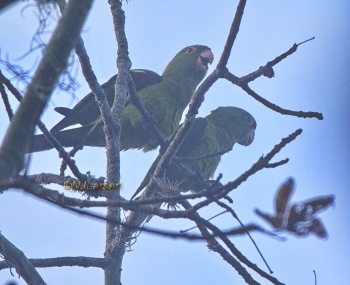KCFoggin-243 (talk | contribs) |
|||
| (One intermediate revision by one other user not shown) | |||
| Line 1: | Line 1: | ||
| − | [[Image:Red | + | [[Image:Red-masked_Parakeet_by_NJLarsen.jpg|thumb|400px|right|Photo © by {{user|NJLarsen|NJLarsen}} <br />Jorupe reserve, Loja, SW [[Ecuador]], 8 June 2019]] |
;[[: Category:Psittacara|Psittacara]] erythrogenys | ;[[: Category:Psittacara|Psittacara]] erythrogenys | ||
==Identification== | ==Identification== | ||
| − | + | ||
33 cm (33 in) | 33 cm (33 in) | ||
*Red forehead, crown and face | *Red forehead, crown and face | ||
| Line 13: | Line 13: | ||
For information regarding identifying Red-masked Parakeet from hybrids with [[Mitred Parakeet]], see [http://www.birdforum.net/showthread.php?p=3686050 this thread] in the ID forum. | For information regarding identifying Red-masked Parakeet from hybrids with [[Mitred Parakeet]], see [http://www.birdforum.net/showthread.php?p=3686050 this thread] in the ID forum. | ||
==Distribution== | ==Distribution== | ||
| + | [[Image:Red Masked Parakeets 3-23-2014.jpg|thumb|350px|right|Believed to be a non-hybrid<br />Photo © by {{user|Pauhana|Pauhana}} <br />Miami, [[Florida]], March 2014]] | ||
[[South America]]: found in western [[Ecuador]] and [[Peru]] down to around Lima. Naturally seems to be limited to less than 1100 m asl, but are currently found also in Quito and similar places, possibly due to escaped birds forming feral populations. | [[South America]]: found in western [[Ecuador]] and [[Peru]] down to around Lima. Naturally seems to be limited to less than 1100 m asl, but are currently found also in Quito and similar places, possibly due to escaped birds forming feral populations. | ||
| − | Feral in the [[USA]] ( | + | Feral in the [[USA]] ([[California]], [[Hawaii]], parts of [[Florida]]), and in [[Puerto Rico]]. Feral flocks may be intermingled with other species, notably [[Mitred Parakeet]], with which this species can hybridize. |
==Taxonomy== | ==Taxonomy== | ||
| Line 24: | Line 25: | ||
Deciduous woodland and bordering areas, including acacia scrub. | Deciduous woodland and bordering areas, including acacia scrub. | ||
==Behaviour== | ==Behaviour== | ||
| + | [[Image:033 Red-masked Parakeet Juv P1120137.jpg|thumb|350px|right|Juveniles<br />Photo © by {{user|njlarsen|njlarsen}}<br />Jorupe reserve, Loja, SW [[Ecuador]], 11 June 2019]] | ||
====Diet==== | ====Diet==== | ||
Probably varies with season and habitat, but includes fruit. There is little other detailed information available. | Probably varies with season and habitat, but includes fruit. There is little other detailed information available. | ||
| Line 29: | Line 31: | ||
They nest in termite mounds or tree holes. The clutch consists of 3-4 eggs which are incubated for 23-24 days. The young fledge after 50 days. | They nest in termite mounds or tree holes. The clutch consists of 3-4 eggs which are incubated for 23-24 days. The young fledge after 50 days. | ||
==References== | ==References== | ||
| − | #{{Ref- | + | #{{Ref-Clements6thAug18}}#Handbook of the Birds of the World Alive (retrieved Feb 2018) |
#BF Member observations | #BF Member observations | ||
{{ref}} | {{ref}} | ||
Latest revision as of 01:05, 9 October 2019
- Psittacara erythrogenys
Identification
33 cm (33 in)
- Red forehead, crown and face
- Bright green overall plumage
- White eye-ring
- Red underwing coverts, thighs, and the leading edge of the wings
Juveniles differ in having red in the face restricted to just the area surrounding the bill.
For information regarding identifying Red-masked Parakeet from hybrids with Mitred Parakeet, see this thread in the ID forum.
Distribution
South America: found in western Ecuador and Peru down to around Lima. Naturally seems to be limited to less than 1100 m asl, but are currently found also in Quito and similar places, possibly due to escaped birds forming feral populations.
Feral in the USA (California, Hawaii, parts of Florida), and in Puerto Rico. Feral flocks may be intermingled with other species, notably Mitred Parakeet, with which this species can hybridize.
Taxonomy
Formerly placed in genus Aratinga.
This is a monotypic species[1].
Habitat
Deciduous woodland and bordering areas, including acacia scrub.
Behaviour
Diet
Probably varies with season and habitat, but includes fruit. There is little other detailed information available.
Breeding
They nest in termite mounds or tree holes. The clutch consists of 3-4 eggs which are incubated for 23-24 days. The young fledge after 50 days.
References
- Clements, J. F., T. S. Schulenberg, M. J. Iliff, D. Roberson, T. A. Fredericks, B. L. Sullivan, and C. L. Wood. 2018. The eBird/Clements checklist of birds of the world: v2018. Downloaded from http://www.birds.cornell.edu/clementschecklist/download/
- Handbook of the Birds of the World Alive (retrieved Feb 2018)
- BF Member observations
Recommended Citation
- BirdForum Opus contributors. (2024) Red-masked Parakeet. In: BirdForum, the forum for wild birds and birding. Retrieved 10 November 2024 from https://www.birdforum.net/opus/Red-masked_Parakeet






